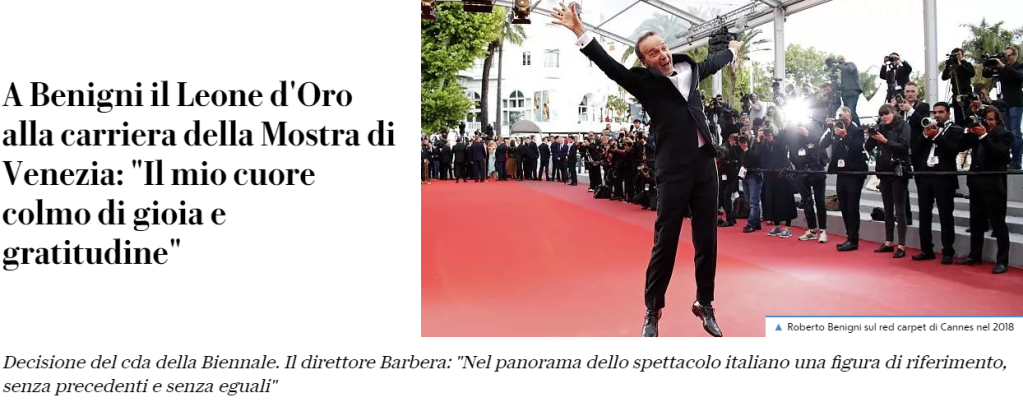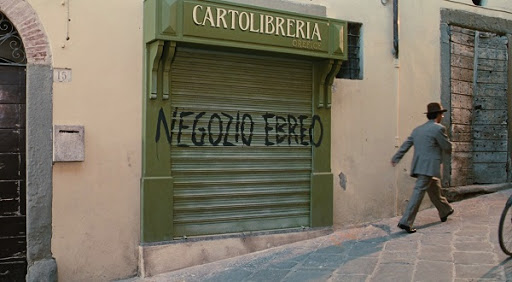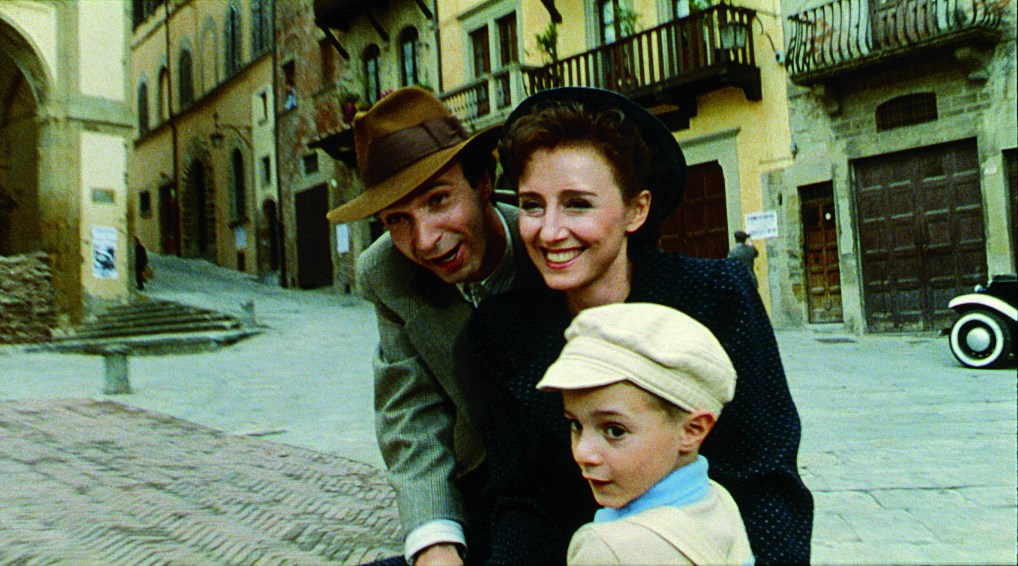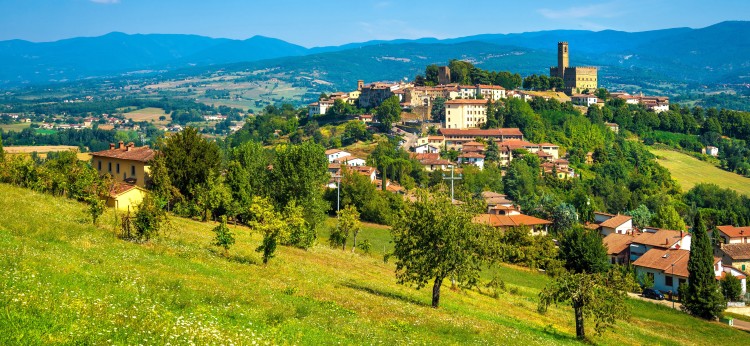Each time I sit down to write about Italian films and the emotions that they provoke I find myself thinking about more and more different films and I realise that there is always another film to consider. However, this time it’s a single film, a unique film, that dominates my mind. A film that is joyful and tragic, memorable and painful, in equal measure. A film that stays with you long after it has finished. I’m talking about the superb and cinematographically exquisite ‘La Vita e Bella’. A masterful creation from Roberto Benigni.
LA VITA E BELLA – Life is Beautiful (1997) was directed, co-written and starred Roberto Benigni. The film is visually stunning. The opening scene of two friends in an open-top car cruising the highways of Tuscany has been permanently etched into my brain. The year is 1939 in the ‘Kingdom of Italy’ the sun is shining and the countryside is gorgeous. Life is lush and green and abundant. In the first half of the film Tuscany and the city of Arezzo dazzle in their beauty. Benigni plays Guido a cheerful and mischievous character heading to Arezzo to work in his uncle’s restaurant. He soon spots Dora, a beautiful young teacher, who is already engaged to a wealthy but unattractive local businessman. Undaunted, Guido sets out to win her heart. Their courtship is hilarious. By 1944 the couple are married and have a son. They run a book shop together. By this time the storm clouds of war have darkened the sun drenched hills of Tuscany. Italy is occupied by the Nazis and the deportations have started.
‘La Vita e Bella’ is definitely a film of two halves. The second half is as dark and tragic as life can be. The little family is deported and separated. Guido and his son end up in a concentration camp where Guido’s ingenuity and comic skills come to the fore. He creates a game and a series of challenges out of the grim experience of daily life to entertain his son. He completely refuses to give in to despair.
In November, 2018 I wrote an article about Italian films entitled Italian Films to make you laugh, cry and think… My dear friend John Eaton, responding to my article suggested that I should include ‘La Vita e Bella’ in any future writing about Italian films. John was gently pointing out that ‘La Vita e Bella’ should really have been included in the first article. I’m ashamed to say that it’s taken a long time for me to follow his advice. Here’s what Mr John Eaton had to say more than two years ago…….
Hi, Janet,
What a different, entertaining and interesting departure from your usual “travelogue” contributions! As a Film buff, I was delighted to see you mention three of my favourite foreign films, and agree completely with your choices.
At the risk of stealing your thunder (as I’m sure it would be the next one on your list – but just to make sure!) I trust that your next list will include one of the funniest but saddest Italian Films ever – “La Vita e Bella” (“It’s a Beautiful Life”) made by, and starring, the brilliant Roberto Benigni. (He has been described as “a kind of manic cross between Woody Allen and Jim Carrey; he creates the kind of tragi-comic hero you can’t help but end up rooting for”).
As another Review put it: “This magnificent film gives us a glimpse of the Holocaust, but it is really about love, and the indomitability of humanity even in the midst of inhumanity”. It certainly deserved the three Oscars which it won, and the scenes of Arezzo (and other locations in Tuscany) are beautiful. However, a word of warning (if any of your readers haven’t already seen it, and are tempted to watch it on DVD) – the first half of the film is Italian Comedy at its best – delightful and hilarious. The second half could not provide a starker contrast – harrowing in the extreme; and the laughter which the first half produced, was equalled in amount and volume by the tears which the second half of this unforgettable film produces. I defy anyone to watch it without being moved to those two extremes of emotion!
Thank you again
John
The truth of the matter was that I’d found ‘La Vita e Bella‘ such a wonderful film, but also such a tragic film, that I couldn’t bring myself to remember and write about Guido and his ordeal. I kept finding another subject to write about or another film. Then about a week ago whilst reading www.repubblica.it one of Italy’s best newspapers I came across an article reporting that Roberto Benigni was going to be honoured with a Lifetime Award for his contribution to cinema at this year’s Venice Film Festival. I realised that the time had come to write about ‘La Vita e Bella’ and Benigni’s extraordinary genius.

I suppose for me ‘La Vita e Bella‘ was initially a film of great beauty and joy. It made me want to visit Arezzo, where the film is set and also to explore the rolling hillsides of rural Tuscany. It made me think about life and love and romance. Benigni as Guido is charming and endearing, it is easy to understand how he captures Dora’s heart. As the film progresses and the family’s blue sky existence is exchanged for a black and grey world of prison camps and guards, the mood turns very sombre. However Benigni’s character remains a bright light of optimism and hope. Guido’s devotion to his son and his dedication to their survival is as painful as it is poignant. A reminder to us all of the suffering endured by Italy’s Jewish community during those dark war years.
1943 was a dreadful year in Italian history. The Second World War was at its height and Italian Jews were being deported to prison camps in the north. Many were sent to Auschwitz in Poland. This terrible tragedy was made worse by the fact that the Allied Forces had already landed in Sicily and Salerno in September, 1943 and were making their way north through the Italian peninsula. Many Italians believed that the war was over. Tragically there was still another two years to go. In Ferrara, one of my favourite small cities near Bologna, the Italian Jewish community were all deported in 1943 and 1944, the vast majority never returned. The thought that these innocent people were being herded onto freight trains within months of the end of the war fills me with the most profound sorrow.
When ‘La Vita e Bella‘ was first released there was some criticism, in certain circles about the film and the bleakness of the prison camps. However when it came to the awards season the film won three Academy Awards. In fact Roberto Benigni, a man of great talent and humility, commented on winning the second award, that he had nothing to say because he’d used up all his English accepting the first award! He also famously kissed Martin Scorsese’s feet when he heard that his film had won the ‘Grand Prize’ at the Cannes Film Festival in 1998.
The film is a masterpiece of hope and determination. A film that shows great light and joy, whilst also embracing the horrors of the Holocaust. It is a film of profound importance when we consider the events of the last hundred years. I’d like to offer a special thank you to John Eaton whose encouragement and gentle commentary persuaded me to write and think a little more about this exceptional piece of cinema history.
In the words of Alexander Solzhenitsyn, ‘If only there were evil people somewhere insidiously committing evil deeds and it were necessary only to separate them from the rest of us and destroy them. But the line dividing good and evil cuts through the heart of every human being. And who is willing to destroy a piece of his own heart?‘
NOTES
- ‘La Vita e Bella’ is a 1997 Italian film directed by and starring Roberto Benigni. He co-wrote the film with Vincenzo Cerami. Benigni plays Guido Orefice, a Jewish Italian bookshop owner, who employs his fertile imagination to shield his son from the horrors of internment in a Nazi concentration camp. The film won three Academy Awards and numerous other prizes. Partly inspired by Benigni’s father, who spent two years in a German camp during the Second World War. Link to wikipedia entry for ‘La Vita e Bella’ https://en.wikipedia.org/wiki/Life_Is_Beautiful
- Alexander Solzhenitsyn quote from The Gulag Archipelago (1973)
- Further reading: Italian Films to make you laugh, cry and think…
- The Leopard and other exceptional Italian Films…
- Venice and Film – thoughts from the oldest film festival in the world
- Ferrara and Giorgio Bassani – where I discuss the fate of the Finzi-Contini family
Original film trailer (USA):
April 2021




Hi, Janet!
Well! – you wouldn’t expect me NOT to comment, would you?
Your commentary about one of my favourite films was spot on, and considerably enhanced by the inclusion of the photographs both of the countryside, and from the Film itself – including the trailer, which produced yet another flood of tears from the emotional impact and memories evoked by this masterpiece by Roberto Benigni.
Thank you for taking up the earlier suggestion, and producing such a relevant and readiable addendum to your earlier series!
As ever
John
LikeLike
I hadn’t heard of this film, Janet–thank you for the recommendation and your thoughtful, introspective look at it.
LikeLiked by 1 person